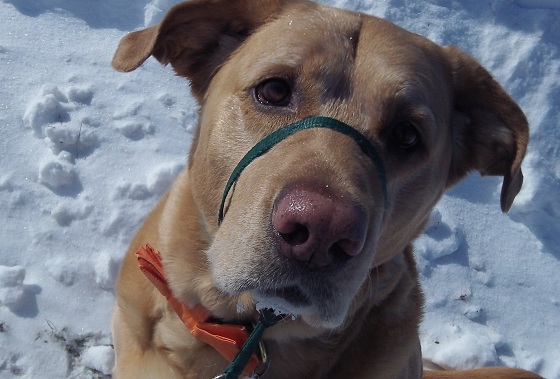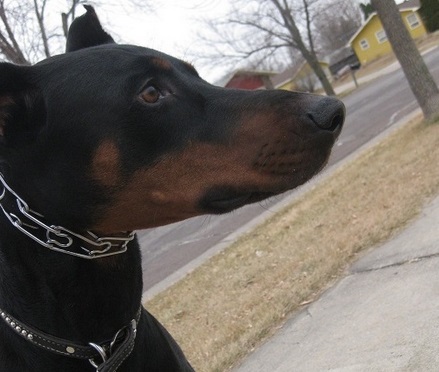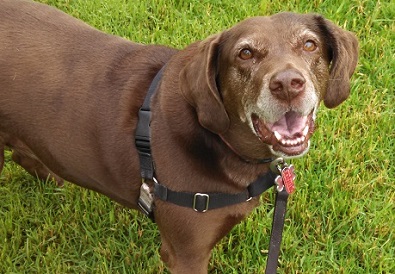Which collar is best to stop a dog’s extreme leash pulling?
And I mean extreme pulling! Most dogs will pull, but some take it to another level, if you know what I mean.
In my opinion, the best collars to stop a dog’s leash pulling are the Gentle Leader or the prong collar (pinch collar).
I’ve tried almost every collar possible, and those two collars work the best on the widest variety of dogs.
Of course, it also depends on the individual dog as well as the owner’s comfort level and openness to different tools.
What do you think? Let me know in the comments.

More about the Gentle Leader and the prong collar
The Gentle Leader is considered a “head halter” and fits around the dog’s muzzle, as shown below on Hunter. If the dog pulls, he has to pull with his face vs. his neck or chest, which is obviously uncomfortable and less effective.
The prong collar fits around the dog’s neck and should be kept high, right under the dog’s chin and behind the dog’s ears. It should not cause the dog any pain. But, like the Gentle Leader, it makes pulling uncomfortable and ineffective for the dog.
You can read my post on the Gentle Leader vs. prong collar, but here’s what I like and don’t like about each tool:

What I like and don’t like about the prong collar
Pros of the prong collar
1. Almost always effective if used properly
2. Works well for dogs with shorter muzzles who can’t wear Gentle Leaders
3. Easier to transition to a regular collar
Cons of the prong collar
1. Needs to be fitted properly
2. Most dog owners don’t know how to use them correctly
3. You have to stop and adjust the collar often to keep it high on the neck
What I like and don’t like about the Gentle Leader
Pros of the Gentle Leader
1. It works well for giving the dog owner more control
2. Almost all dogs are easier to handle on a Gentle Leader vs. a collar around the neck
3. It has a calming effect on a lot of dogs
Cons of the Gentle Leader
1. The thin piece of nylon can start to rub into the dog’s skin or eyes
2. Won’t fit dogs with short muzzles (pugs, English bulldogs)
3. Most dogs dislike having something over their muzzles
What about an anti-pull harness?
Some people love anti-pull harnesses, which typically clip to the dog’s chest instead of the dog’s back.
I find I don’t have as much control with any harness compared to a Gentle Leader or a prong collar, especially if the dog is reactive to other dogs or things like skateboarders. I need to be in control, and a Gentle Leader or prong collar is generally what helps me the most.

However, an anti-pull harness can work well for some dogs, particularly those with short muzzles and wide necks like English bulldogs or pugs. This is because their muzzles are too short for a Gentle Leader or their necks are just about as wide as their heads.
Also, if you don’t want your dog to look intimidating, a colorful harness tends to make a dog look friendlier than a metal prong collar or a Gentle Leader, which can be mistaken for a muzzle.
And here’s another issue I hear about all the time with Gentle Leaders:
My dog pulls so hard the Gentle Leader is rubbing his skin raw
The dog is pulling so hard that the Gentle Leader is actually rubbing off the dog’s fur or making the skin raw, even causing him to bleed.
A similar problem can occur with an anti-pull harness as well, except the rubbing occurs under the dog’s arms. And understandably, some owners are concerned with prong collars too, if the dog is still constantly trying to pull against the collar.
I have the same problems with some of the dogs I walk, and here’s my tip:
Rotate which collar you use from walk to walk
Yes, buy a prong collar and a Gentle Leader and rotate between the two.
This may sound odd, but if you have an extremely strong puller, you know what I’m talking about.
If the dog pulls so hard the Gentle Leader is pulling into the dog’s eyes or rubbing her skin raw, just switch to a prong collar every other day to give your dog’s face a break.
Or, perhaps you could try an anti-pull harness if you don’t like prong collars.
Just have two different options available that work so you can switch it up from time to time to give sensitive areas a break.
Heck, I’ve even switched collars halfway through walks with one of my foster dogs. I preferred the Gentle Leader with him, but he pulled so hard against it that I had to switch to the prong collar after a half-hour or so to give his eyes a break.
Just be careful if you’re going to be clipping and unclipping collars and leashes during a walk, obviously.
OK, now I want to hear from you.
Does your dog pull? What collar works the best for controlling your dog?
Sign up for That Mutt’s newsletter here.
Related blog posts:
Is it time to stop using choke collars?

Lesley Roberson
Monday 26th of November 2018
One of my dogs, a boxer/lab mix, 90 lbs. plus (I had to put him down a year ago this passed December, he was 11-1/2) was a puller. We tried the gentle leader but he would rub his face on the ground to get it off and his face would bleed. I now have a rhodesian ridgeback/lab mix, 64 lbs. I've had him for 1 year. He's been in intermediate classes 4 times. He still pulls me. Especially when he sees a cat or a bunny. I didn't try the gentle leader because of my experience with "Riot" my boxer/lab. He came to me with a no-pull harness, that didn't work. We then got a few other harnesses that didn't work either. We tried the Martingale Collar, he slipped out of it to go see a dog. We used the prong collar for a couple months. He did better with that. Although, when he took his good citizen test, he was visiting with other dogs before the test, the collar broke. He is now in a harness. Sometimes he has good days but mostly bad days. I've tried holding a "special" treat in my hand and put it near his nose or say "watch me" so he will watch me going down the street with treat near my eyes. Once he realizes he's not getting the treat, he stops healing and watching. I have read Rhodesian Ridgebacks are very stubborn. I can attest to that!!! However, he is a very loving dog.
Lindsay Stordahl
Monday 26th of November 2018
With my weim, I rotate between the prong collar, Gentle Leader and a no-pull harness depending on what we're doing. They all work OK in their own ways but like your dog he pulls all the time. So I'm just saying I understand!
Barbara Rivers
Friday 24th of February 2017
I quickly replaced the Gentle Leader with the Halti because the pups rubbed off some hair on their muzzles with the GL, and the Halti has that beautifully padded noseband. I used the Halti to teach polite leash walking, and it has worked great - it's what I still walk Buzz on. I currently use a slip collar on Missy in order to be able to control her when we come across cats and squirrels on our walk. She just really wants to go after them!!
I've also used prong collars and as you said, it's important to learn how to use them correctly. Most people don't adjust them by taking out links and just put them around their dogs' necks, like a flat collar. That will definitely cause injuries.
Bruce Bolduc
Thursday 23rd of February 2017
Our dog pulls so strongly that she made the circle link that joins the chain on the Martingale collar to an oval. 24 pounds of muscle. We may transition to a prong collar. The harness doesn't really change her behavior.
Jen
Thursday 23rd of February 2017
I started each of my 3 dogs out as puppies with a Halti, and spent A YEAR walking them with it while also practicing loose-leash walking. A. Year. They all hated the Halti, spent much of the walk trying to paw it off, and were incredibly miserable. Eventually, I transitioned each of them to a prong collar. I chose it because two of my dogs' fur is so thick, that it was the only tool that seemed to get through all of the layers of dog hair and actually be effective. My third dog was a very nervous Rhodesian Ridgeback, and he startled at everything approaching him from behind, particularly motorcycles, bicycles and strollers. It was the only way to keep from being pulled off my feet. Daily walks eventually helped him relax around such forms of transportation, and it only took one instance of him lunging and trying to get away to realize he didn't want to pull against a prong collar. He walked good as gold after that, as long as the collar was on. Take it off, and he'd pull against his flat collar til he choked. I actually felt like the prong collar did less harm than the flat one, in that case.
I never used prong collars for training, only for walking, and I made sure to buy the appropriate size for each dog.My smallest dog has a very lightweight one that has very small links, which I have been quite impressed with. The standard link size would, I feel, have been too much for her.
My oldest dog turned 13 in January, and has slowed down enough with age that she no longer needs the prong collar, and hasn't worn one in two years. My youngest one probably doesn't need it any more, either- her pulling, I've learned, is not due to excitement or energy, but is because she isn't able to walk at the pace appropriate for her physiology. She pulls because walking with the older dogs is too slow for her. I read an article recently about how a dog's proper gait and their comfort is all dependent on walking at a certain pace. Walking slower than that can actually be harmful for their skeletal frame, so they either have to speed up and "pull" in order to walk comfortably, or slow down too much, which is also awkward and unpleasant for them. If I walk her by herself. She doesn't pull at all.
The Ridgeback passed away unexpectedly last April. at 9 years old. His successor turned 1 earlier this month, and we have worked really, really hard NOT to use a prong collar with that one- though there have been days when I desperately needed it. He's doing nicely on a Martingale collar, these past 6 months, and he's another one that needs to walk at a certain pace in order to keep a loose leash. We had to transition from a flat collar to the Martingale because his pulling when he was younger was so bad we were afraid he'd break loose of the collar. He was attacked last August (badly) by a dog that escaped a yard, and then two weeks later, he startled so badly at another loose dog that he bolted, dragging me through the street. He was barely 80lbs at that point. My old one was 90 and never pulled THAT bad. Poor kid. He was so scared that, when he realized I wasn't going to turn loose of the leash, he began racing in circles in the street- my bare knee being the pivot point and bearing the brunt of it all. He did 3 full turns before he finally stopped and cowered in fear. I still have scars from the road rash- my ankle, knee and elbow bearing the brunt of it, the knee being the worst. We've worked really hard to bring him back from that awful incident, and he's come along way. If he'd had a prong collar, I might have been spared injury, though.
A person definitely has to consider their dog, their own needs,and chooses the collar that best suits the both of them.
Jen
Thursday 23rd of February 2017
P.S. In case readers misunderstand my above post, I didn't mean to imply that I began puppyhood teaching them to walk with a Halti- I only employed it once they were several months older, and past that instinctive "following naturally" phase, and were more interested in pulling ahead to further their own pursuits. at 13 and 6, they walk really well... unless they spy a rabbit or deer (squirrels are old news and don't warrant the same degree of excitement). Also, buzzards produce a very extreme reaction for some reason. We've lived in a lot of rural areas where various wildlife are encountered often. There were days when, if not for the 90lb Ridgeback by my side, the other two (their combined weight was the same as his) would have pulled me off my feet. He really wanted to lunge and pull and try to chase the deer, too, but he knew he had that prong collar on, and so would just stand still, instead. When you're walking multiple dogs at once, and their total weight is much more than your own, and you're in rural areas where you don't know what might be around the next corner, you want to be sure you're able to keep everyone under control.
Not a Dog Whisperer
Wednesday 8th of February 2017
I wish I could say that by reading this blog, I gained some clarity on what I should do with my two dogs. Resolutions for everyone are different. I understand that dogs respond differently, but I have tried everything. Mine are not "aggressive", they play with other dogs, I think that is part of my problem. One is an English Mastiff, the other American Staffordshire Terrier. The Mastiff pulls and he gets very excited when he sees a dog. I used collars, and he breaks them. I have used a choke chain, but he pulls to where he can't breath, no matter how early I try to catch him to correct him, he puts his weight into the collar or chain to pull. I was told by a trainer to use the prong collar, which I argued and fought about for a long time, but I gave in. He still pulls like a train when we are coming to a yard that has a dog at the fence. My daughter wants to use a harness but the trainer said the harness will just give him the urge to pull more. So lost. Everyone has such great ideas and success with what they have done and I feel like I have no options for taking the big guy out for walks since every neighbor in my neighborhood has either pit bulls or german shephards at the front yard fences. Then there is the Staffie. She pulls but not as much. She smaller and easier to handle and correct. Her problem is she gets really excited and makes this high pitch whine and sort of a yippie and chirping bark when she sees or hears another dog. This just recently started when she was two. Very embarrassing. No idea how to fix that either! Would love to get suggestions...
Lindsay Stordahl
Wednesday 8th of February 2017
Have you tried a Gentle Leader that fits over the muzzle? How about having them wear backpacks on walks to give them jobs so they burn more energy and have something to focus on other than pulling. My weim pulls no matter what tool I use so I hear ya. I'm using a prong collar most of the time and he still pulls with it.